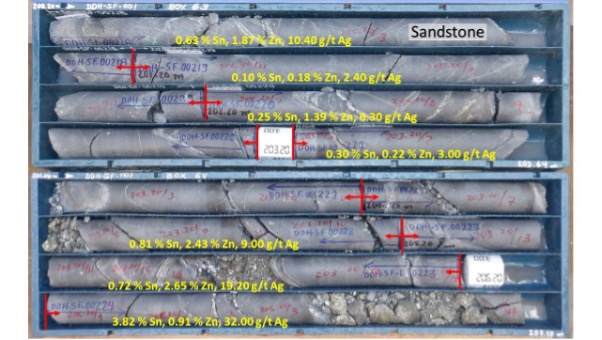Whitehorse Gold Corp. (TSXV: WHG) has identified a lengthy zone of mineralisation in assay results of its first confirmation drill hole (DDH-SF-001) for the SF Tin Project, located in the Oruro Department, Bolivia.
This is one of the two drill holes to confirm two historical holes reportedly drilled by Rio Tinto. The assay results for the second confirmation hole are pending.
Hole DDH-SF-001 was drilled at the same azimuth and dipping angle as (azimuth of 90° and -60° dip) as the historical hole ESF001 but was collared 15 m apart.
DDH-SF-001 intersected 200.7 m grading 0.4% tin, 1.28% zinc, and 12 g/t silver from 139.2 m to 339.9 m, comparing with the 200 m grading 0.44% tin, 1.22% zinc and 13 g/t silver for the historical hole ESF001.
DDH-SF-001 intercept also includes a higher-grade sub-interval of 68 m grading 0.62% tin, 1.69% zinc and 13 g/t silver; comparing with 68 m grading 0.49% tin, 1.22 zinc, and 9.3 g/t silver. In addition, DH-SF-001 has also intercepted a two-meter interval from 30.20 m to 32.20 m grading 79.8 g/t silver and 0.67% lead.
CEO and Director, Gordon Neal, said the company is satisfied that the hole DDH-SF-001 has confirmed the historical drill hole ESF001.
“We are very encouraged by the close comparison between our first confirmation drill hole and the historical hole. This is an important step for us to proceed with the completion of our final acquisition of the SF Tin Project,” Mr Neal said.
Based on the option agreement signed in August, subject to satisfactory confirmation drill results, the company will proceed to acquire 100-per-cent interest in the SF Tin project by paying a total of US$3.65 million over two years.
Mineralisation intersected in hole DDH-SF-001 is hosted in fine to medium-grain sandstone of a blackish-gray color (greywacke) with clusters of multiple veins/veinlets which contain pyrite, sphalerite, galena, cassiterite (SnO2), and trace amount of stannite (Cu2FeSnS4).
For further information please visit: https://whitehorsegold.ca/












